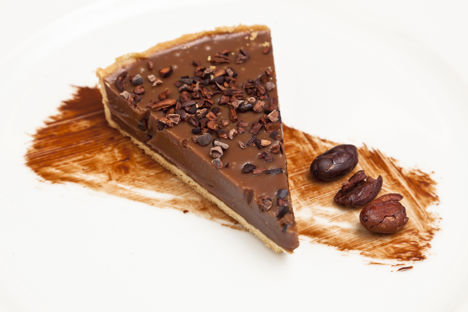Cacao nibs or cocoa nibs are shards of cocoa bean most often associated with the chocolate-making process — though more and more they are being used as an ingredient in their own right.
The primal ingredient has pure and bitter cacao flavours, meaning that they work in both sweet and savoury dishes. It's the nibs' texture which is particularly distinctive though. The shards have a lot of bite. They're harder than most nuts, almost like crystallised sugar —certainly more comparable to a Brazil nut rather than a softer almond or pecan.
Cacao nibs are created as part of the chocolate-making process. The cacao beans are roasted and then 'cracked' — separating the husks from the nibs. A technique called 'winnowing' blows the husks away, removing 25% of the original weight, and leaving the cocoa nibs behind.
At this point, the nibs are most commonly ground into a chocolate liquor, and then mixed with milk, sugar and emulsifier to make chocolate. But more often than ever, nibs are removed and packaged, and sent to restaurant kitchens round the world, to star in dishes as an ingredient in their own right.
Cacao nibs are renowned for their high levels of anti-oxidants. They are also a good way of introducing chocolate flavours to diets which wouldn't otherwise allow it, like veganism. Increasingly, cacao nibs are found in high street health shops, as well as speciality online food shops. As with purchasing chocolate, it's advisable to look for organic, and ethically-sourced products.
How to cook with cocoa nibs
Cacao nibs are sold both roasted and raw. The roasted nibs have more developed and intense flavours. It is, of course, possible to roast raw nibs at home. Follow the same process as for roasting nuts — spread the nibs on a baking tray, and place them in the oven at 180°C for 5-10 minutes, keeping a keen eye on them, and constantly sniffing the air to ensure that the nibs don't catch and blacken.
Nibs are most often taken straight from the packet, and sprinkled over dishes as a textured garnish. To change the size of the shards, use a chef's knife to chop them as you'd chop nuts. The nibs can also be pounded in a pestle and mortar and ground into a powder in a coffee grinder (the coffee remnants often enhance the flavour!)
Another interesting application is infusing the cacao nibs in a milk, cream or custard. It means that you introduce chocolate flavours to a dish without any brown chocolate colour. Add approximately two heaped tablespoons of nibs to 500ml of liquid (dependent on how strongly-flavoured the liquid should be). Gently heat and then strain.
What cocoa nibs go with
Introduce cacao nibs to chocolate desserts - help pick out the more complex, bitter notes of a chocolate mousse, chocolate fondant or chocolate torte. Unsurprisingly, the flavours of cacao nibs make a natural partner to other flavours known to go well with chocolate, like fresh or dried fruits, caramel, coffee and nuts.
The hard texture of cacao nibs make it an interesting replacement for nuts in granola, brownies and biscuits. Also use it as a garnish to top soft mousses and parfaits, and experiment with more unusual applications like tuiles.
Get in touch
Please sign in or register to send a comment to Great British Chefs.



